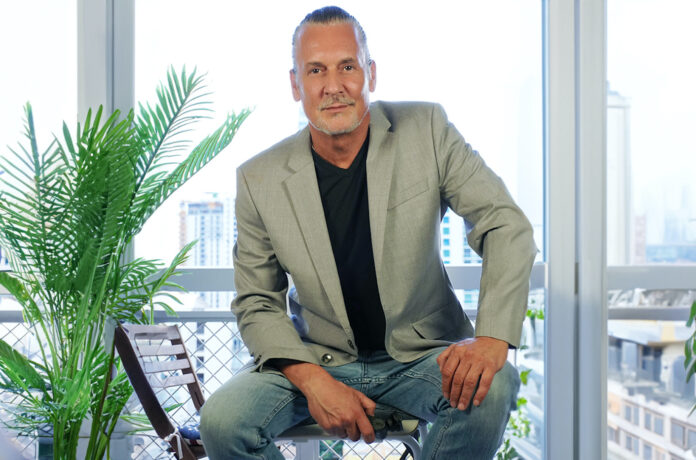In the early days of adult use, companies made big bets on how and why consumers would engage with cannabis and planned their products and manufacturing accordingly. Designing and prototyping new technologies was a big part of the process, and a handful of pioneers and visionaries became particularly notable for innovations that impacted the industry in ways they may never have imagined. Marc Beginin, at the time a criminal defense attorney in Michigan who represented cannabis offenders, was one such pioneer in the extraction sector, where he continues to shape the industry.
Today, the extracts and edibles segments account for nearly 50 percent of cannabis sales in the United States, but that hasn’t always been the case. Extracts were a tiny part of the total until the first vaporizer pens appeared in 2010, shortly before Colorado became the first state to legalize adult use. Vapes made puffing more socially acceptable and opened a massive new product category. But the technology for making the extracts to fill the devices remained crude and somewhat dangerous for about five years. “Open blasting,” one of the primary extraction methods, involved shooting butane through plant material in a narrow container to extract the precious oils.
In 2014, Beginin teamed up with Nick Tennant, who for several years had been tinkering with new designs for more sophisticated and safer extraction machines. Together, they founded Precision Extraction Solutions with an initial investment of $45,000. Precision helped launch a new market segment when it began offering off-the-shelf, turnkey “closed loop” extraction systems capable of safely isolating the plant’s chemical components and refining them into new, high-end—and, by then, highly sought—products.
Precision was in the right place at the right time, as the U.S. cannabis industry was entering a major growth stage with dozens of states gearing up for adult-use sales. By 2019, the company’s annual revenue skyrocketed to more than $40 million; in June 2021, Beginin orchestrated a merger with Cascade Sciences, creating a formidable equipment and solutions provider for extraction, post-processing, and testing. Then, a scant three months later, Massachusetts-based Agrify Corporation acquired the combined entity for $50 million in cash and stock. Beginin initially opposed the transaction but capitulated after negotiating what should have been “a poison pill” into the contract: He wouldn’t be constrained by a noncompete clause.
“It really should have killed the deal,” he said. “It’s crazy. Let the founder and largest shareholder and [chief executive officer] walk away with a ton of money and no noncompete [agreement]? Not a good idea.”
In 2022, Beginin founded Prodigy Processing Solutions, a designer and manufacturer of premium next-level, high-volume extraction equipment. Based in Miami with manufacturing operations in Hartville, Ohio, the company’s equipment meets or exceeds Food and Drug Administration (FDA), current Good Manufacturing Processes (cGMP), and European Union GMP (EU GMP) standards for food and pharmaceutical applications. All equipment is made in the U.S.
Over the course of his career, Beginin has served in several C-suite capacities in the industry. With his new company, he seems more motivated than ever to continue pushing the envelope on extraction technology. Partially, that’s because he envisions a near future when every company in the U.S. will have to adopt much more stringent manufacturing processes to ensure products meet standards set by the FDA and other regulatory bodies.
And partially, it’s because he just can’t give up on his long-standing role as an advocate. Ever since his days defending targets of the war on drugs, he’s wanted to change the landscape.
Why was Precision so successful?
We launched in December 2014 and really shot out of a cannon. We offered the first commercial closed-loop hydrocarbon extraction system. At the time, butane was being used to extract oil from the plant, but there were a lot of people just open blasting … and as they got larger and larger scale, that’s when you blow up an apartment or garage or whatever. So safety quickly became a big issue.
So we came out with really the first commercial system and, sight unseen, we collected a lot of deposits and produced a lot of equipment. And we did it right; we really ran the business like a business—certainly not like a hobby. And then we just continued to innovate and grow over time.
How did Prodigy build on your previous extraction-sector experience?
Prodigy has the benefit of nine years of lessons learned [at Precision]. And that means everything from the technology to the people to the suppliers to the innovation. At Precision, we did final assembly testing for our own proprietary goods; we had third-party manufacturers build the components and then we would put them together. At Prodigy, our manufacturer is our business partner: Mitchell Fabricators in Hartville, Ohio. This was also a manufacturer for Precision toward the end of my tenure there, when we were moving to U.S. manufacturing because we learned the Chinese [components manufacturers] were woefully inadequate—and not just in terms of the quality of the builds but also the materials used. When they would say, “it’s 304 stainless steel,” it was something else.
At Prodigy, because the manufacturer is literally an equity partner, now we can produce 316L stainless steel that is made in the USA and manufactured at top-notch quality, because we don’t have that gap where we have to buy from a manufacturer, they mark it up, and then we mark it up. And that’s why we can afford to make quality products in the USA at reasonable prices.
Who are Prodigy’s target customers? What types of products are you developing for them?
Our target customers are sophisticated processors and extractors in the cannabis and hemp industries—the ones who value providing quality to their customers. They’re the [multistate operators], the publicly traded companies, and the sophisticated operators. If they’re not already GMP-compliant, they’re leaning into good manufacturing practices, which substantially has not been a thing in the cannabis industry due to [the plant’s] federal illegality.
This is why we’re making pharmaceutical-grade equipment. And there are no hydrocarbon systems out there that are GMP-compliant except for Prodigy’s. The whole industry was started with open blasting, so it’s been focused on operator safety, but now it’s shifted to consumer safety and testing for pesticides, heavy metals, mold, mildew, things like that. But [contemporary industry standards are] woefully inadequate as compared to FDA and GMP standards, whether food or pharmaceutical. So now, because of rescheduling, recalibrating for FDA and GMP compliance will be imminent.
Also, if our customers become FDA-compliant and DEA-registered labs, they can do work for pharma, and then they will be able to operate in all fifty states and cross state lines legally. It’s the ones that want to lean into pharma and the ones that are intense and meeting the standards that are going to come to us sooner or later on the recreational side. Your average lab that is just Frankensteining equipment together and pumping out some products, they don’t care and they are not our customer. But the ones that truly value operating in a highly sophisticated business manner—meaning really focusing not just on operator safety but also on consumer safety—they are going to be around for the long term, because they know the changes are coming. Why would you invest a half-million dollars into a piece of equipment that you know the FDA will not deem compliant when the time comes?
The industry expects cannabis’s status under the Controlled Substances Act to change sometime this year. How challenging will it be for extraction labs to meet new standards if the FDA and other agencies step in afterward?
Well, it’s going to be very easy if they use Prodigy equipment. We were built on the inevitability of cannabis becoming federally legal, and it turns out that is happening first by the switch to Schedule III. [The Department of Justice and Drug Enforcement Administration are considering moving the plant to a much-less-restrictive classification that it currently holds. —Ed.] So here comes [the pharmaceutical industry], and this is an opportunity—a massive opportunity—for these labs. They have decades of experience that pharma doesn’t have. To meet those standards, it’s a learning curve, upgrading the equipment and the [standard operating procedures]. But with the proper guidance, it’s not that complicated, and it’s an investment in the future, that’s for sure.
What do you think are the most meaningful ways in which rescheduling will impact the industry?
Well, the change will usher in an [Internal Revenue Code Section] 280E exemption, but that’s more for the larger companies that don’t have a workaround already. I’m confident most companies have that anyway and are able to deduct business expenses. They often have [human resources] handled by a different company for their employees, as well as marketing and [other non-tax-deductible] things like that. That is significant, because without 280E you can easily just deduct your expenses. That’s a big one. I don’t believe that affects most operators out there, but it is significant because now it is also a signal to say, “Okay, we don’t have to play games with our accounting,” and people can just easily do more straightforward accounting.
I believe [dispensing with 280E] should open up banking as well. That’s maybe going to take a few more hoops to jump through, but the tax deduction is a big one. It’s just a formal setting in motion of the road toward full legality in some fashion. Specifically, it is the opportunity presented to these processors to clean up in terms of their business.
For example, if they are developing precursor extracts for pharma, [those products go] to some other lab for final separation and inclusion in a pharmaceutical product or compounding prescription that’s legal under Schedule III. That is huge. So they’re going to be able to do fifteen to twenty times the sale price of what they’re already doing.
Or they can do the chemical separation and provide those components or take it all the way to a finished product. I think the word isn’t out yet on how these labs can capitalize on this massive opportunity.
What are the real safety issues in the extraction industry these days?
Consistency and adhering to certain protocols in order to call them “standard operating procedures” and really sticking to them are geniune issues. In terms of operator safety, let’s just check that box as if we’re good, because normally the authority having jurisdiction is the municipal or county fire chief. They regularly have fire marshals do inspections, but operator safety during production is where problems happen.
Who’s doing consumer safety inspections? For cannabis, that’s the local health department, which is ill-equipped in terms of even a knowledge base to deal with a consumer food product. They’re too busy checking in on the local family restaurants and Taco Bells to make sure they’re adhering to their [standard operating procedures], which they understand very well. When you’re dealing with a [traditional] consumer product, the FDA does the inspections.
Companies are motivated to get a product out the door, and many of these labs may require someone to sign a piece of paper [certifying the product] that’s not actually part of their process. So again, when it comes to cleanliness and not leaving things lying around, moving things, it’s all about contamination. That’s the name of the game here. And that contamination doesn’t necessarily need to be a pesticide or a heavy metal; it can be bacteria. This is what you’re guarding against: contamination of all sorts. But if you use the proper equipment and engage with the proper procedures, you minimize that risk to some level.
Butane is a popular solvent. Could using butane in the extraction process lead to any health hazards?
Butane is a hydrocarbon and, generally speaking, it results in the fullest profile [of the plant] you’re going to get at the commercial level. The solvent at certain temperatures and pressures flows over the biomass and pulls out the material components and chemical compounds you desire. So it pulls what you want, like the terpenes, flavonoids, CBD, THC, all the cannabinoids, and it leaves behind what you don’t want, like chlorophyll. That’s it. That’s the magic of it.
Now you have a mixture of solvent, cannabinoids, and other chemical compounds that goes to what we would call the collection vessel, where it’s heated. The solvent turns into a gas that boils off, and what you have left is the oil. And then you would further purge it [to remove any residual contaminants].
Another thing to consider is you probably can’t go a day without eating some sort of soy extract in something. Soybean oil is extracted using hexane, which also is a hydrocarbon. It’s sort of on the nastier end of hydrocarbons. This stuff has been going on forever, and it’s so common. The hydrocarbons boil off and you get down to non-detectable amounts, or they’re totally purged when you’re [finished with the process]. So it’s not really a health issue.
Competition is intense in this industry. What is the key to thriving in this market?
The liquor industry is similar to ours—or it’s going to be very similar, I believe, once cannabis is federally legal on the adult-use side. Back in the late 1990s, I started a vodka company—actually a brand called Zodiac—and eventually we got into twenty-two states. I was bought out of that company in 2005, but in the meantime I gained a lot of experience in dealing with a highly regulated industry. I don’t think cannabis is unique. Whether you’re running Apple Inc., General Motors Corporation, or a lemonade stand or restaurant, I’d say the fundamentals are all the same. Everything is consumer-focused, and this is what matters: providing value to the consumer.
Now, how do you do that? By creating a high-quality product that’s desired and then communicating to the consumer why they should want it. Building a great company culture and all the things that go along with that in terms of maintaining proper operations, costs, and the like support that mission. As federal legalization approaches, even beyond Schedule III, [the market will become] more competitive, not less, because now you have all these businesses getting involved that wouldn’t before, which means you’re going to have more sophisticated competition. If operators haven’t upped their game yet, they’re going to have to up their game soon.
You’re from Michigan, which recently leapfrogged California to become the state producing the most revenue. What makes Michigan so successful?
Yeah, we’re crushing it, and the market in California has four times as many people. California consumes way more cannabis than Michigan, but [California’s sales are] not all legal. In addition, California’s regulations, laws, and taxation are abusive, so they’re suppressing the legal market. In Michigan, on the other hand, medicinal and recreational use were legalized by public referendum. The referendums weren’t written by legislatures or people that had a ton of competing interests. They were written by pro-cannabis lobbyists—or just activists, actually. So now we have a market where laws and regulations are conducive to business. That’s why Michigan is thriving.
There’s an incredible entrepreneurial spirit and grit in [Michigan] as well. So you have healthy competition between a lot of people, and there’s no vagueness to compliance with laws and regulations. And there’s no overtaxation, either. That’s why it’s so successful.
Do you see any new categories of extraction products coming along in the near future?
I think the sky’s the limit for products, because everything that’s not flower is using extract, whether it’s a vape pen or a gummy, chocolate, a topical, sublingual, or cosmetic products—you name it. Every product you see out there that has cosmetic, nutraceutical, medicinal, or food value, you can use cannabis extract for. So I think it’s really up to the creativity of the brands and manufacturers.











